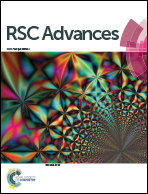An ultrasensitive fluorometric platform for S1 nuclease assay based on cytochrome c†
Abstract
An ultrasensitive and straightforward fluorescent sensing platform for S1 nuclease activity has been developed based on S1 nuclease-induced DNA strand scission and the difference in affinity of cytochrome c (Cyt c) for single-stranded DNA (ssDNA) containing different numbers of bases. This sensing platform consists of a negatively charged fluorophore carboxyfluorescein (FAM) labeled 20-mer ssDNA (20F) and a positively charged protein Cyt c. In the absence of S1 nuclease, the electrostatic and hydrophobic interaction between 20F and Cyt c makes the FAM be in close proximity to Cyt c, resulting in efficient quenching of the fluorescence of FAM. Conversely, and very importantly, in the presence of S1 nuclease, it cleaves 20F into small fragments. The introduction of Cyt c into the sensing solution results in weak quenching of the fluorescence of FAM due to the relatively weak electrostatic interaction between the fragmented ssDNA chains and Cyt c, making the FAM move away from Cyt c, and thus the fluorescence intensity gradually increases with increasing concentration of S1 nuclease. S1 nuclease can be detected in a range of 4.0 × 10−3 to 4.0 × 10−2 units per mL with a detection limit of 8.3 × 10−4 units per mL and good selectivity. Moreover, the sensing system is used for the detection of an inhibitor of S1 nuclease with satisfying results.


 Please wait while we load your content...
Please wait while we load your content...